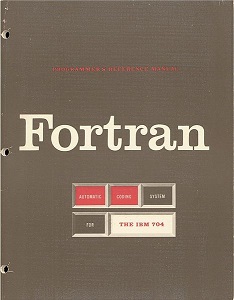On this day in 1954 the first successful Fortran program runs. Fortran is a general-purpose, imperative programming language created by a group at IBM led by computer scientist John Backus. Formerly FORTRAN (in all caps), its name is derived from “Formula Translation”, and it was created as a more practical language for programming the IBM 704 mainframe computer.
Fortran is still being used today in a variety of scientific and engineering applications, making it one of the oldest programming languages still in use. It’s often the language of choice for high-performance computing and is used for programs that benchmark and rank the world’s fastest supercomputers.

The first Fortran programming manual published in 1956 – image taken from www.edn.com
Fortran IV was my first programming language at Arizona State University, back in 1969. That was when we used card punches and tab cards to program with. I still have my classroom book from back then.
Fortran IV was too my first programming language at Genoa University (Italy), back in 1981. I don’t understand its power and reliability just when i try to debug “modern” language program like C++ with the aid of a complete IDE environment.
When a FORTRAN code compiled its makes what you want to do.
Ahhh, wonderful memories. In 1966 at Queen’s University, Belfast, programming in FORTRAN. And the computer was in Harwell, Oxfordshire so the punched cards went by post, with the printed output coming back up to a week later! Fortunately the staff at AEA Harwell were quite good at correcting silly programming mistakes, so it wasn’t quite so bad as it sounds…
… and I thought I was old…
That was the year I was born!
My only experience with FORTRAN was a bit of experimenting with UCSD P-System FORTRAN on an Ohio Scientific C2-4P in the early 1980s.